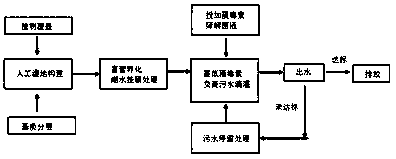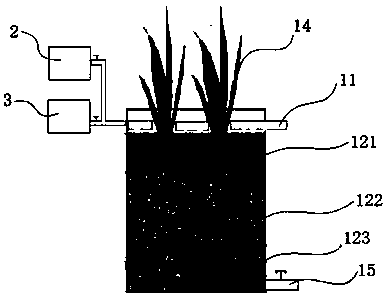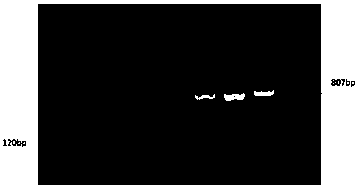Method and system for enhancing constructed wetland to remove microcystis and toxins in water
A technology of microcystin and artificial wetlands, which is applied in chemical instruments and methods, water pollutants, biological water/sewage treatment, etc., can solve the problem of unsatisfactory removal of extracellular toxins, toxic and harmful by-products, and increased extracellular toxins and other problems, to achieve the effect of reducing the water body residence time, good removal effect, and efficient treatment
- Summary
- Abstract
- Description
- Claims
- Application Information
AI Technical Summary
Problems solved by technology
Method used
Image
Examples
Embodiment 1
[0051] This example provides a method for strengthening constructed wetlands to remove microcystins and toxins from water bodies, which uses the combined action of exogenous microcystin-degrading bacteria and indigenous microorganisms in constructed wetland biofilms to improve the removal efficiency of constructed wetlands for algae and their toxins ; The method of using exogenous microcystin-degrading bacteria is to enrich and increase the concentration of microcystins from the water body of the outbreak of Microcystis blooms, and regularly detect the gene mlrA of the degrading bacteria during the enrichment process to confirm that the degrading bacteria culture time, until the concentration of microcystin-degrading bacteria in the microcystin-degrading bacteria solution is 1×10 6 ~2×10 6 cell / m 2 After the above, the bacterial solution is applied to the constructed wetland.
[0052] The constructed wetland adopts subsurface flow constructed wetland, and the wetland matrix ...
Embodiment 2
[0082] Embodiment 2 The present invention is to the removal effect test of nutrient salts such as nitrogen and phosphorus
[0083] Construct and utilize the subsurface flow constructed wetland system and method described in Example 1, use a 10 L PVC plastic barrel to construct a constructed wetland with an effective volume of 2.5 L, and fill the substrate with 5 cm soil layer and 15 cm gravel ( The gravel was washed with tap water before filling, and the bottom layer was filled with 5 cm large-grained zeolite (20 mm) to prevent the water outlet from being clogged, and 3 yellow calamus plants were evenly planted in each device.
[0084] Device operation: After the device is completed, eutrophic lake water is used for irrigation and cultivation for one year, and nutrients are artificially added. The concentrations of nutrients such as nitrogen and phosphorus in the influent are shown in Table 2:
[0085] Table 2 Influent Water Quality
[0086]
[0087] Nitrogen and phosphorus ...
Embodiment 3
[0088] Example 3: Removal test of algae cells and soluble microcystin LR by enhanced constructed wetlands
[0089] Construct and utilize the subsurface flow constructed wetland system and method described in Example 1, evenly invert the degrading bacteria composite bacteria solution on the surface soil of the wetland, mix the composite bacteria solution and the soil matrix evenly by plowing, and domesticate for a week. The initial microcystin MC-LR concentrations were set at 3.61 μg / L, 6.80 μg / L, and 16.07 μg / L, respectively. After one-time water intake, stay in the wetland for 7 days, and collect 1mL water samples at 0h, 6h, 12h, 24h, 48h, 72h, 96h, 120h, 144h, and 168h for the determination of EMC-LR.
[0090] The optimal hydraulic retention time of the wetland system is 3 days. Under this hydraulic retention time, the removal rate of the constructed wetland system for toxin-producing algal cells (endotoxin IMC-LR) is 73.5%-95.4%, and for Microcystis extracellularis The rem...
PUM
| Property | Measurement | Unit |
|---|---|---|
| Thickness | aaaaa | aaaaa |
| Particle size | aaaaa | aaaaa |
| Thickness | aaaaa | aaaaa |
Abstract
Description
Claims
Application Information
 Login to View More
Login to View More - R&D
- Intellectual Property
- Life Sciences
- Materials
- Tech Scout
- Unparalleled Data Quality
- Higher Quality Content
- 60% Fewer Hallucinations
Browse by: Latest US Patents, China's latest patents, Technical Efficacy Thesaurus, Application Domain, Technology Topic, Popular Technical Reports.
© 2025 PatSnap. All rights reserved.Legal|Privacy policy|Modern Slavery Act Transparency Statement|Sitemap|About US| Contact US: help@patsnap.com



